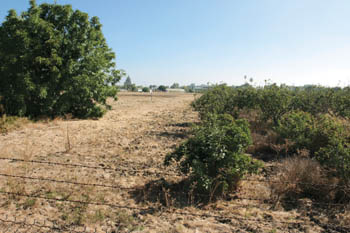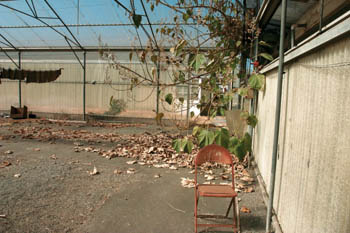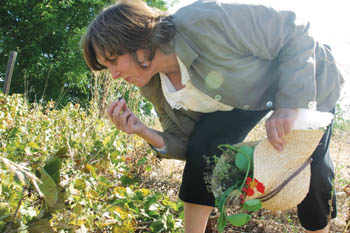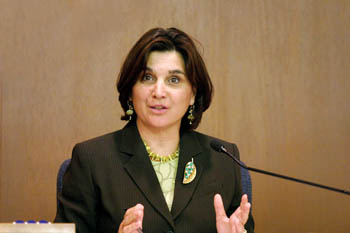![[Metroactive News&Issues]](http://metroactive.com/gifs/news468.gif)
[ Silicon Valley | Metroactive Home | Archives ]
Dirt Don't Hurt: The land in question, a 17-acre parcel of undeveloped space near the Valley Fair mall that was formerly the University of California's Bay Area Research and Extension Center, or BAREC.
Secret Gardens
How a 17-acre parcel of land in the heart of Silicon Valley went from agricultural open space to the planned Santa Clara Gardens development is a matter of considerable controversy. Critics say it was secret deals and hush money, and they're not taking it lying down.
By Vrinda Normand
TO REALLY SEE what this story is about, you have to go to the Valley Fair mall parking lot at the corner of Winchester Boulevard and Forest Avenue. Circle up the ramps until you get to the top level. Walk to the edge of the lot facing Winchester and look out. What you'll see, literally across the street, is a massive open field dotted with a few fruit trees and faded greenhouses.
You may never have noticed this undeveloped oasis before because it is bordered on three sides by single-story houses and on one by a row of tall shrubs. But you can be sure developers know about this 17-acre morsel, growing over with weeds while its fate is being decided.
Just three years ago, this land was buzzing with activity. The property, owned by the state of California, used to be called the Bay Area Research and Extension Center (BAREC), an agricultural research hub run by the University of California since the 1920s. Because of its unique place in the heart of Silicon Valley, BAREC brought master gardeners and scientists together to study issues unique to this area.
But neither its success with agricultural research nor its value as open space in Silicon Valley was enough to save BAREC from the bottom line. This is the story of a fight that some may call futile, a six-year protest waged by citizens who don't think it's beyond the imagination to keep a farm one block away from Santana Row. They say questionable connections between politicians and developers have propelled a deal that has left the community in the dust.
Land of Plenty
The trouble began in the summer of 1999. Former directors Zak Mousli and Craig Kolodge say that at that time, BAREC was thriving. A few years prior, they had been told to expand so that every inch of the property was utilized for innovative research. They grew mushrooms on compost made from kitchen scraps and yard waste, recycling something urbanites generally throw away to produce one of Santa Clara County's highest-value crops. They developed ways to make compost that wouldn't scare off city dwellers with stink and flies. They tested new varieties of turf and came up with solutions for local plant diseases. Several times a year, they hosted Field Days, inviting the community to see their work, taste their specialty crops and get free gardening advice.
When John Azevedo bought a house bordering the edge of BAREC, he thought the open space on the other side of the chain-link fence in his backyard was just a nice field. He soon realized, he says, "what a great benefit it was to the community."
But decision-makers in the upper echelons of the UC, Mousli says, "didn't care about what BAREC was doing.
"The UC had control over the BAREC land as long as they considered it necessary for research," he says. "Otherwise, they would have to give it back to the state."
Because of its location, BAREC eventually became a very valuable bargaining tool. The UC's Cooperative Extension, which gets half of its funding from the state, was struggling after major budget cuts in the early 1990s. So, in a backroom deal that offered no opportunity for public input, UC officials traded BAREC for a $2 million annual funding increase that was supposed to be permanent.
For Kolodge, it was a bureaucratic slap in the face. "It came as a complete shock," he says. "It was a mystery how it happened."
Mousli was equally embittered by the way things went down. "It was scam from the very beginning," he says. "These are supposed to be educators, but they don't really care about the people."
BAREC neighbor Angela D'Orfani felt the same way when she read about the center's closure in the local newspaper. She had a 5-year-old kid and was pregnant with a second, but she didn't let that stop her from knocking on all the doors of the houses bordering the property. When her neighbors answered, she would hold up a copy of the article. "What do you think of this?" she asked. Almost everyone, she says, was surprised and upset.
Many were compelled do something about it, so they organized a meeting at D'Orfani's house and formed the Winchester Open Space Committee. This would be the first grassroots effort to save BAREC.
Raging on the Public Stage
The neighbors, it turns out, weren't the only ones up in arms. Then-state Sen. John Vasconcellos found out about the deal when Mousli called asking why it had been made. "We were like, 'Wait a minute, what is he talking about?'" recalls Jose Villarreal, the senator's former aide.
Vasconcellos immediately pulled together a town hall meeting to get to the bottom of what had happened. In October of 1999, over 150 citizens watched as he openly chastised UC officials for what he characterized as shady dealing. In later letters to the UC president and then-Gov. Gray Davis, he wrote, "Given the surreptitious manner in which this deal was made between the UC and the Davis administration (i.e. the huge budget document, at the last minute, with no notice to anybody—the local residents, us, the local legislators that represent that area) this whole deal should be called off, and the process legitimately renewed with full public notice and involvement."
In other correspondence, the senator called the process "truly abominable" and "utterly untenable." Vasconcellos pleaded with Davis to grant the Cooperative Extension budget augmentation without tying it to the BAREC land.
He might as well have been screaming in deaf ears. In August of 1999, six months before the UC Regents gave final approval, the UC Business and Finance office represented the deal as sealed in a letter to the Santa Clara County Open Space Authority (who had protested the closure). In addition, the UC tried to save face by devaluing the urban agricultural research. The letter to the OSA read, "Over the past few decades the nature of research conducted there has changed and BAREC has come to be regarded as underutilized, particularly because of its location in the midst of the highly urbanized Santa Clara Valley."
According to Mousli, this was just one of many lies the UC would tell. The former director says Steve Nation, spokesman for the University's Division of Agriculture and Natural Resources, called him shortly before a private meeting that was to be held in February 2000 with Vasconcellos. Nation allegedly told Mousli that the ANR vice president Reg Gomes was upset with him and wanted him to stand behind the UC's decision. Mousli says he asked him not to speak out and, in exchange, promised to relocate all of the BAREC employees.
During the private meeting, attended by a dozen people including D'Orfani, Vasconcellos pointedly asked Mousli if his agricultural research could be conducted anywhere else. Mousli says he opened his mouth to respond, but Gomes jumped in and said the research could certainly be done elsewhere.
"That was total BS," the former director says. The BAREC studies, focused on the surrounding Silicon Valley community, had to be conducted in the South Bay climate.
Mousli says he was never consulted about relocating the research, and despite assurances that the UC would do so, no such action has been taken six years later. Mousli says he had to fight to get just one of his gardeners a job at a Central Valley research farm.
Nation says he never asked Mousli to refrain from criticizing the UC's deal. Nor, he says, did he make any promises about the BAREC employees.
"We value academic freedom in the university, and would never tell someone they could not express their views," says Nation.
Despite the support letters that flowed in from citizens, organizations and public agencies, the UC didn't budge.
"By the time all this came to light," Villarreal says, "the deals had already been made and there was no turning back."
In March 2000, the UC Regents voted to close BAREC, stating it was no longer necessary for agricultural research, and that the budget augmentation for the statewide Cooperative Extension was of substantially greater benefit. The sole dissenting trustee, San Jose attorney Stephen Nakashima, warned that the state wasn't obligated to uphold its promised funding.
Turns out he was right.
According to financial documents from the UC ANR, the Cooperative Extension
did receive its $2 million augmentation for two years. Then, in 2002, the state cut
$2.5 million from the budget. The following year, it cut $12.5 million. Now the program is running on far less than it did in the 1990s.
Meet the Resistance
When the control of the land went to the state, and talks about its sale began with developers and the city of Santa Clara, critics say things only got worse. One of those critics is Kathryn Mathewson, who lives a few miles from the BAREC property and has been following the twists and turns of its fate for three years.
The fiftysomething landscape architect has a passion for plant life and open space. She has created a rural oasis in her backyard, surrounded by the tranquil Rose Garden neighborhood in north San Jose. Numerous flowers and herbs flow over meandering footpaths. Twenty-three fruit trees hide fences and create the illusion of a country setting. In the morning, the sun filters through the leaves and illuminates the flowers, which attract birds, butterflies and bees throughout the day.
The beauty of land in its natural state has driven Mathewson to fight for the last remaining bits of undeveloped property in Silicon Valley. Despite her relaxed demeanor while in her "secret garden," Mathewson's sharp tongue and bold criticism make her a force to be reckoned with.
"We've been watching them like hawks," she says with a gleam in her eye.
"We" is the group called Save BAREC, formed in the fall of 2002 when concerned citizens met with the Santa Clara Planning Commission to discuss BAREC's reuse plan. At the time, the Winchester Open Space Committee had dissolved, but many individuals were still raising their voices. Most wanted to keep the land as open space, for agricultural education and a city park.
Mathewson found a core of 10 activists to join her in lobbying local politicians. As a collective of environmentalists, historians, educators, politically savvy housewives and retirees, they've made their case on radio shows, public television programs and City Council meetings. They've given presentations to the local Green Party, the Sierra Club, the Santa Clara County Board of Supervisors, the county Board of Education, the county Water District, the San Jose City Council and several neighborhood associations and environmental groups. So far, they've received support from over 2,000 organizations and individuals.
Despite these efforts, Save BAREC has found that the city of Santa Clara is less concerned about any of this community input than it is about the interests of developers and the state. After discovering fishy campaign contributions, they have begun to suspect members of the City Council are in bed with the property's stakeholders.
True Values
From the beginning, it was clear that what the state wanted in selling BAREC differed from what many community members wanted.
"Our goals were to obtain the highest and most certain return for the taxpayers of California," says Matt Bender, spokesman for the state Department of General Services (DGS).
When asked about the taxpayers of Santa Clara County who value the land as open space, Bender responded: "There are a lot of competing values to consider."
But how much did the state consider the nonmonetary ones? In the summer of 2002, California's DGS hired a consultant named Daniel Potash to work with the community and the city government. He met with a handful of BAREC neighbors, including D'Orfani, to ask what they would like to see. They all expressed a desire for open space.
Potash was "pretty slick," D'Orfani says, shifting the conversation to gauge how much development the community would be willing to accept. They preferred low-density housing that blended into the neighborhood, but this was only the lesser of the evils.
"It was like they were trying to figure out what they could persuade us to do," D'Orfani remembers. They spent the meeting discussing plans for housing development with an architect named Daniel Hillmer when, ultimately, that wasn't what the neighbors really wanted.
Then Santa Clara jumped on board with the state. Councilmembers Rod Diridon and Jamie Matthews attended the neighborhood meetings with the consultants, both favoring housing on the BAREC site. That year, they had each received campaign contributions from both Potash and Hillmer.
Because the state had to offer the land to local public agencies before it could auction to private developers, Santa Clara had first dibs. The city also had zoning power to determine how the property was used.
With that in mind, nearly 300 residents crammed into the Valley Village community center in November of 2002 and January of 2003 to give their input to the Santa Clara Planning Commission. They talked about the traffic that more development would bring to the neighborhood, with its already near-congested intersections on Winchester and Stevens Creek boulevards. They worried about parking problems getting worse.
One woman stood up and asked for a show of hands: how many people wanted open space on BAREC? At least three-quarters of the room raised their arms. At the end of the session, several commission members commented that the vast majority of the community seemed to want open space and nothing but that. They said this would reflect in their recommendation to the City Council, which makes the final decision.
At the following City Council meeting, various options for BAREC were discussed. The state had offered the land to the city for half the market value (set at $3 to 4 million per acre) if it was used for open space or affordable housing. Santa Clara had $20 million reserved for redevelopment that they considered using for low-income senior housing on the site. As a compromise, Councilmembers John McLemore and Dominic Caserta motioned to keep at least half of BAREC as open space (9 acres) and develop the remaining property for senior citizens.
Matthews and Diridon (who had received money from the state's consultants) motioned to keep only 1 acre for a city park and leave the rest for development. The council would vote at the next meeting.
This is where the democratic process went out the window. McLemore says the council met with the state consultants in private to discuss negotiations that wouldn't be appropriate to conduct in public. But they also held informal votes during these closed sessions that determined the majority opinion. When it came time to debate the process openly, McLemore says, the minority knew they were the underdogs and refrained from speaking up.
"No new public arguments changed any of the minds that were made during closed session," the former City Council member adds.
Santa Clara's leaders sided with Matthews and Diridon. In February 2002 they voted to keep a 1-acre park on BAREC. The city purchased 6 acres from the state to be used as senior housing, and the remaining 10 acres went to the Palo Alto-based developer SummerHill Homes owned by George Marcus.
Incidentally, Marcus is also a UC regent and a powerful political player. Since 1999, he has made over $2 million in political contributions across the state of California. This includes campaign money given in 2004 to current Santa Clara City Council members Kevin Moore and Patrick Kolstad.
Ironic Gardens?
Santa Clara Mayor Patricia Mahan is quick to defend the council's final decision. "I thought we came up with a very creative solution," she says about using the redevelopment funds to build senior housing. Within the 6-acre complex, the city plans to incorporate some gardens and open space. They've since changed the name of the BAREC site to "Santa Clara Gardens."
The developer, Mahan points out, also considered the community's preference for low-density housing. SummerHill Homes plans to build single-family houses on 10 acres, next to a 1-acre memorial park as a gesture to BAREC.
During City Council meetings, Mahan told the community the city simply couldn't afford to buy the land and keep it as open space. Mathewson from Save BAREC doubts Mahan tried hard to find funding from outside sources that would be sympathetic to the city's need for more open space.
In March of 2003, the Santa Clara County Open Space Authority received a letter from City Manager Jennifer Sparacino asking for assistance in the BAREC purchase. The request, however, was not for obtaining additional open space. It was for the senior housing and 1-acre park the council had already voted on.
OSA director Patrick Congdon says he then notified Santa Clara about the special funds every local jurisdiction gets from property taxes levied by the Authority. At the time, the city had $280,000 available if they applied for it. According to Congdon, the city did not follow up on that option for BAREC. It later requested this amount for another project in the Ulistac Natural Area.
What's more, San Jose took interest in BAREC because many of its residents live along the property, and much of the traffic from development would end up inside San Jose borders. Councilmember Ken Yeager supports open space for the site, which he points out is lacking in this area. BAREC is in the only district that doesn't have a county park.
Yeager met with Mahan to discuss a joint project. He says he offered some of the city's parks money to help. But the mayor didn't follow through.
"I think Santa Clara always envisioned that property being developed," Yeager says.
Mahan says she and Yeager only talked about parks money "in concept," and a firm offer was never made. When asked how far she went to pursue that funding, Mahan said her staff "looked into it."
The mayor has also shied away from the challenge of withholding residential zoning from the developer. "We can't withhold zoning arbitrarily, unless you want to subject this city to a lawsuit that will bankrupt it," she said at a City Council meeting in April 2005. "It's just not going to happen, and I'm sorry to say, that's just the reality of it."
In a later interview, Mahan explains that it would be risky for the city to keep BAREC as agricultural zoning because it is surrounded by residential and commercial development.
But Palo Alto land-use attorney and former Atherton Mayor James Janz says the city could easily argue that it needs to keep the area as open space. Janz believes a developer is unlikely to sue the city for withholding zoning because doing so would jeopardize future business. He adds that he has never heard of a state suing a locality for this reason.
Studying Possibilities
The Legislature finds and declares that the preservation of land in its natural, scenic, agricultural, historical, forested or open-space condition is among the most important environmental assets of California. The Legislature further finds and declares it to be the public policy and in the public interest of this state to encourage the voluntary conveyance of conservation easements to qualified nonprofit organizations.
—from California civil code
section 815
As of this month, the sale of the BAREC land is still pending. The delay is partly due to an Environmental Impact Report that must be completed before the city changes the zoning. This study has opened a new can of worms, and community members are jumping at every chance to prevent development.
Save BAREC members continue to show up at city meetings, presenting a slew of environmental concerns related to pesticides once used on the research farm. Mahan assures them that no housing will be built until the land is thoroughly cleaned. The planning department expects to release the EIR in the spring of 2006.
During this limbo period, activists are letting everyone know that the sale is not final. They won't give up until the developers start laying their foundations. For the past two months, members of Save BAREC have manned a table at the Santana Row farmers market on Sundays. Kirk Vartan, who also manages the website www.savebarec.org, eagerly takes the opportunity to let market-goers know "It's not too late!" He rallies his group members—"We need to be out there, with our feet on the street, knocking on doors!"
Although they haven't stopped development yet, Save BAREC activists have attracted a lot of attention. In the first two weeks of October, their website has received over 6,000 hits, the same as the total for all of September. Their peak month this year was April, when they logged over 16,000 visitors.
Top visitors to the site include the state Department of General Services and SummerHill Homes. Vartan and Mathewson frequently update reports on BAREC's status, including phone numbers of city officials to contact and video downloads of council meetings.
Despite feeling that she has been thwarted at every turn, Mathewson maintains hope. She repeats the phrase that has kept her going for the past three years.
"The community does matter," she insists. "It does."
[ Silicon Valley | Metroactive Home | Archives ]
Copyright © 2005 Metro Publishing Inc. Metroactive is affiliated with the Boulevards Network.
For more information about the San Jose/Silicon Valley area, visit sanjose.com.
![]()

Photographs by Felipe Buitrago

The remnants of what former BAREC directors say was unique agricultural research on the land.

Kathryn Mathewson, one of the nearby residents, who is fighting development on the land as part of the group Save BAREC.

Different Vision: Santa Clara Mayor Patricia Mahan says the city couldn't afford to buy the BAREC land and keep it as open space. 'I thought we came up with a very creative solution,' she says.
Send a letter to the editor about this story to letters@metronews.com.
From the October 19-25, 2005 issue of Metro, Silicon Valley's Weekly Newspaper.